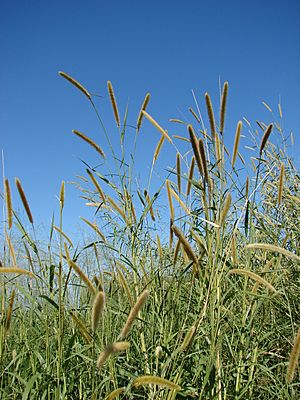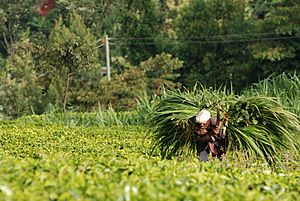Napier grass facts for kids
Quick facts for kids Napier grass |
|
|---|---|
 |
|
| Scientific classification | |
| Genus: |
Cenchrus
|
| Species: |
purpureus
|
Cenchrus purpureus, also known as Napier grass, elephant grass, or Uganda grass, is a type of tall, tropical grass. It grows naturally in the grasslands of Africa. This plant does not need much water or nutrients, so it can grow in places where other crops might struggle.
For a long time, people used Napier grass mainly for feeding animals. More recently, it has become important in a special way to control pests called the push–pull agricultural pest management strategy. Napier grass also helps make the soil healthier and protects dry land from soil erosion. People also use it to stop fires, block wind, make paper, and even create bio-oil, biogas, and charcoal.
Contents
What is Napier Grass?
Cenchrus purpureus is a type of grass that lives for many years. It belongs to the Poaceae family, which includes many grasses. It grows very tall, forming strong clumps that look a bit like bamboo.
This grass usually reproduces by sending out horizontal shoots called stolons. These stolons grow above the soil and create new plants. It rarely produces full seeds. Napier grass does not need much water or nutrients to grow well. A field of Napier grass can produce about 40 tonnes of dry plant material per hectare each year. It can be harvested many times throughout the year.
How Napier Grass Grows and is Harvested
Farmers usually harvest Napier grass often, every 1 to 3 months, when they use it to feed animals. If they use it for energy, they harvest it less often, every 4 to 12 months. When harvested less often, the grass gets more stems and fewer leaves. This makes it harder for animals to chew and digest. However, harvesting less often can sometimes lead to more total plant material each year.
Napier grass can grow very tall, reaching 7 to 8 meters (about 23 to 26 feet) in just four months. It grows best in warm weather, between 25 and 40 °C (77 and 104 °F). It grows very little below 15 °C (59 °F) and stops growing at 10 °C (50 °F). Frost can kill the top parts of the plant, but it will grow back when the weather gets warm and wet again. It can grow from sea level up to over 2,000 meters (about 6,500 feet) high.
You can plant Napier grass using seeds, but it is often hard to collect enough seeds. A better way to plant it is by using stem cuttings from the stolons. You can plant these cuttings in rows, about 75 cm (30 inches) apart.
How Much Napier Grass Can Be Grown?
The amount of Napier grass a field produces depends on many things. These include how farmers manage the crop, the quality of the soil, and the amount of rain, sunshine, and temperature.
Scientists have studied Napier grass to see how much energy it can produce. In Malaysia, one study found that regular Napier grass produced the most, about 65 dry tonnes per hectare each year. Another type called King Grass was close behind, with 62 tonnes. In Colombia, King Grass can produce 40 to 60 dry tonnes under perfect conditions. In drier places like Kenya, the yield is usually less, around 15 to 40 dry tonnes.
Some Napier grass fields have produced up to 80 dry tonnes per hectare per year. Companies that sell Napier grass for farming say it can yield about 100 dry tonnes per hectare each year. This is possible if there is enough rain or irrigation (about 100 mm or 4 inches per month). These amounts are very high compared to other plants grown for energy. For example, large farms growing trees like pines or eucalyptus usually produce much less.
Push-Pull Pest Management
The push-pull pest management method is a smart way to protect crops from insects. It involves planting two different types of plants next to the main crop.
- A "push" plant is planted next to the main crop. This plant repels or pushes away pests.
- A "pull" plant is planted around the edges of the field. This plant attracts or pulls the insects away from the main crop.
Napier grass is great at attracting stemborer moths. These moths cause a lot of damage to maize (corn) and sorghum crops in Africa. So, Napier grass acts as the "pull" crop. This method is much better for the environment and cheaper for farmers than using insecticides.
Stemborers are tiny worms that cause a lot of damage. They burrow into the stems of maize and sorghum plants and eat them from the inside. This makes them hard to find and remove. It also damages the plant's insides, which are needed for growth. These pests cause a lot of crop loss in Africa.
Insecticides often do not work well against stemborers because the worms are protected inside the plant stems. Also, insecticides are expensive for farmers. Pests can also become resistant to chemicals, and the chemicals can end up in the food we eat.
The push-pull method tries to guide the insects away from valuable crops instead of just trying to kill them. For example, farmers plant Desmodium (the "push" plant) between rows of corn or sorghum. Desmodium pushes away the moths when they want to lay their eggs. Desmodium also covers the ground, helps the soil, and reduces the need for weeding.
At the same time, Napier grass is planted around the outside of the field. This grass pulls the stemborer moths away from the main crops. A study in Kenya showed that farmers using this method had great results:
- An 89% reduction in Striga (a harmful weed).
- An 83% increase in soil fertility.
- A 52% success rate in controlling stemborers.
These problems (Striga, stemborers, and poor soil) cause huge crop losses. Using the push-pull method could help many people get enough food.
Making Push-Pull Work Well
For the push-pull method to work best, it needs to be used correctly with other good farming practices. Not all types of Napier grass work as a "trap" plant. Studies show that only certain types, like Bana and Ugandan hairless Napier, attract the female moths well. Farmers are advised to plant three rows of Bana Napier grass around their entire field.
Scientists are still looking for ways to make the push-pull strategy even better. They are studying different plants and natural chemicals that could help. If a field already has a lot of stemborer pests, it is hard to get rid of them. The worms can stay hidden. So, if there is a very bad infestation, farmers should not plant corn or sorghum in that field the next year. Instead, they should plant other crops. It is also important to burn infected plant stalks or leave them in the sun for three days.
Starting a push-pull system needs more work at first. It also needs a large enough piece of land to plant the non-food crops. These things can sometimes stop farmers from using it. However, if farmers can also use the Napier grass to feed their livestock, it gives them another reason to plant it. This can make the system more popular.
Other Uses for Napier Grass
Napier grass is a very important fodder crop for dairy farmers in East Africa. It grows quickly, making it excellent for feeding cattle and buffaloes. Types of Napier grass that are "hairless" are even better for animal feed. Since it can grow with little water and nutrients, it helps farmers use dry lands to produce food. Also, animals can eat the Napier grass used in the push-pull system, giving it another economic value.
Napier grass is also helpful in African landscapes because it stops soil erosion. It can also act as a fire break, stopping fires from spreading, and as a wind break, protecting other crops. It also helps make the soil healthier.
Recently, people have started looking at Napier grass as a way to produce energy. There are large areas of land that are not good for growing food but could grow energy crops. Napier grass can be heated to create charcoal, biogas, and bio-oil. While this technology is not widely used yet, it could provide energy to communities in Africa and also improve the soil. It is also used directly as a source of fuel. The young leaves and shoots of Napier grass are safe to eat and can be cooked in soups and stews.
A company in the Netherlands has even found a way to turn Napier grass into a type of plastic that can be used for packaging.
See also
 In Spanish: Cenchrus purpureus para niños
In Spanish: Cenchrus purpureus para niños


